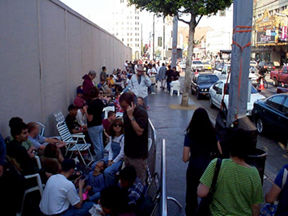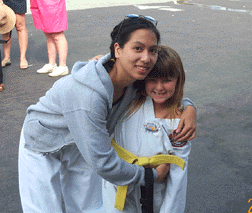I never knew that I could be so coy! I was so shy and quietómore like insecureóaround new people that I tended to keep a physical distance between myself and everyone else. Shaking hands wasnít all that bad really. What was frightening to me was the famous all-American greeting hug, which sometimes followed by a greeting kiss (or two). What I didnít notice at the time was that by staying back and watch, I was learning about Americanís love for personal space. I noticed that Americans donít stand so closely to each other waiting in line, or standing around in a crowded room. Everyone would try to create some space around them. It seemed so peculiar to me for a culture where hugging is a form of greeting.
As I went on to college, I found that the concept of personal space is one of the many concepts categorized under nonverbal communications. It is a subject which people study seriously! Verbal language can be picked up and learned more quickly than the nonverbal cues like body language, gestures, and facial expressions. Personal space and physical contact are the two most prominent and hardest to adjust to of all other nonverbal cues.
Personal Space
What it is: Personal space (Proxemics) is the comfortable distance between one person to the other when they talk, stand, sit, or walk. This personal space varies from culture to culture, and it is a bit difficult to get used to or to adapt to. Americans may seem like they enjoy keeping physical contact with handshakes and hugs. But when it comes to personal space, they donít like someone standing right next to them. If you do a little bit of people-watching (observing other peopleís behavior) in the cafeteria, you might be able to tell who international students are just by how they stand in the checkout line. A person who hasnít adapted to American culture might stand right up to the back of the person in front of him or her, leaving less than 1-foot distance, even though there is plenty of room around. General American norm is about 3 feet.
What to do: Back up a bit. Step away a little. Now that you know Americans like a bit of distance, give them that to be comfortable. Pay close attention to the person and adjust. If he or she seems to keep stepping back, donít pursue. If he or she moves in, that means youíre too far, so stay where you are. You can in turn give your nonverbal cue to others if you feel they are too close or too far. Some people get the clue, and some just donít. You may feel a bit uneasy figuring this out at first. But it gets easier with time and practice.


Even in a crowded, long line, Americans still leave space between themselves.
(This is the line waiting for Star Wars Episode I a couple of years ago!)
What it is: The use of physical touch (Haptics) in America is definitely different from what weíre used to in Thailand, and you know it. Physical touch goes from a hearty handshake, a salutary hi-fives, to a big hug. A hug is offered to congratulate, to affirm, or to support. In a formal setting like a business meeting, or meeting someone for the first time, a handshake would do it. But if itís a friend, itís a hug and sometimes kisses. Friends of different gender hug or kiss each other on the cheeks, and theyíd think nothing of it. Of course itís only natural for you to feel uncomfortable with this aspect of American culture.
What to do: If a hand is offered, bite the bullet and give it a nice grip, and smile at the person. A weak handshake sends off bad impression of anything including insincerity and pretension, and too tight of a shake shows sign of nervousness. You want to give a firm squeeze showing your confidence and sincerity. Same rule apply when a hug is given: a nice firm hug. I understand that itís hard for some of you to abandon the discomfort about hugging, but if you plan to have any relationship with other Americans, youíd have to learn to live with it. For those who are not comfortable with hugs, sometimes you might get out of it by extending your hand for the other person to shake when he or she opens his or her arm. (I emphasize on ďsometimesĒ here). Or just not return a hug. Itís a bit rude, but that is the nonverbal clue youíre giving out to the other that youíre uneasy about hugging. The best thing to do is to explain to them later on that youíre not comfortable.
It took me a while to get used to the hugging among friends. I was somewhat forced into it actually. In theater, the cast members and crew do some friendship-based, bonding activities, and we always ended with hugs. After a while, I got used to it. And I must confess that I actually enjoy giving hugs and getting hugs. Itís like making connection with other people. And itís very reassuring, comforting, almost therapeutic. Give hugging a chance sometimes.
With all due respect to our native culture, Iím not saying that you have to completely give up your personal preferences and belief. But do understand that you are living in America now, and they expect you to adapt to *them*. Nonetheless, to be able to communicate effectively with nonverbal cues, itís a game of give and take. The golden rule of nonverbal communications is to observe and adjust. You make the other person comfortable without making yourself completely uncomfortable. If he or she is as observant as you are, he or she will make the adjustments, and you both would feel comfortable. I also strongly suggest you do some people watching in the cafeteria, mall, or anywhere crowded. Just watch and learn.

Oakley and Jenna exchange a friendly hug.